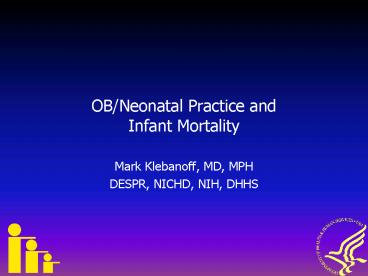OBNeonatal Practice and Infant Mortality - PowerPoint PPT Presentation
1 / 20
Title:
OBNeonatal Practice and Infant Mortality
Description:
Table 1. Infant deaths and infant, neonatal, and postneonatal mortality rates: ... Slide courtesy of Brian Mercer, MD. Willingness to Perform Cesarean ... – PowerPoint PPT presentation
Number of Views:65
Avg rating:3.0/5.0
Title: OBNeonatal Practice and Infant Mortality
1
OB/Neonatal Practice and Infant Mortality
- Mark Klebanoff, MD, MPH
- DESPR, NICHD, NIH, DHHS
2
Table 1. Infant deaths and infant, neonatal, and
postneonatal mortality rates United States,
1933, 1940, 1950, 1960, 1970, and 1975-2001
final, and 2002 (preliminary and latest
processed) Rates per 1,000 live births
3
Perinatal Mortality, US, 2000-2002
NCHS, 2004
4
Calculating Survival Rates
- Infant mortality experience of U.S. is more
complicated than just a number. Clinical
decisions need to be considered - What is the denominator?
- All infants (includes stillbirths)
- All live born infants
- Infants admitted to NICU
- Treatment withheld or withdrawn?
- What is the numerator?
- Neonatal survival (28 days)
- Survival to NICU discharge
- Survival to 1, 2 or 3 yrs
Adapted from Allen, 2004
5
Time Trends in Birth Outcomes - U.S.
From NCHS, 2004
6
Time Trends in Gestation, Single Births - U.S.
From NCHS, 2004
7
Birthweight-specific Mortality, US, 2001
8
Why Has Preterm Birth Increased?
- Multiple births
- fraction of births that are twin and higher order
has increased during the 1990s - increase greatest among non-Hispanic white women,
who presumably have greater access to ART - Why?
- Assisted reproductive technology?
- Increased births to older women?
- Increased obesity in reproductive-age women?
9
Why Has Preterm Birth Increased?
- However, preterm birth has risen among singleton
births as well - 9.7 in 1990, 10.4 in 2002
- All of the increase in singletons has been in
moderately preterm birth (32-36 weeks) single
births lt32 weeks declined very slightly
10
Induction of Labor, US, 1991 and 1998
Zhang, 2002
11
OB Care at the Border of Viability
- Obstetrical Intervention Indicated Preterm
Birth - Cesarean without labor, or induction of labor
- Usually secondary to a medical or obstetrical
complication (most commonly preeclampsia, fetal
distress, IUGR) - Maternal health compromised, and/or prenatal
care-giver decides that the fetus has a better
prognosis in the nursery than in the uterus - Not able to capture indicated births reliably
on the birth certificate (only says method of
delivery, not whether there was spontaneous labor
or PROM)
12
Willingness to Perform Cesarean by Gestational
Age, MFMU Network 1992-3
Bottoms, et al 1997
13
Lowest Gestational Age at Which Obstetricians
Would Perform Cesarean Delivery, 2001
percent
Weeks gestation
McElrath TF. A J Perinatol 20029
14
Delivery Room Care of the 500-749 g Infant,
Cleveland OH
Hack and Fanaroff, 1999
15
Outcome of Liveborn Infants with Birthweight lt750
gColorado, 1991-1996
- Live births 1021 infants
- No intervention 162 infants, all died
- Attempted resuscitation 859 infants
- No response 103 infants, all died
- Response 756 infants
- NICU Care Begun 756 infants
- Basic care only 36 infants, all died
- Advanced Care 720 infants
- Neonatal death 332 infants
- Survivors 388 infants (38)
Hernandez, 2000
16
Neonatal Outcome by Obstetrician Willingness to
Intervene for Infants at 24 Weeks
Willing
Not Willing
S. Bottoms, MFMU, AJOG 1997
Slide courtesy of Brian Mercer, MD
17
Willingness to Perform Cesarean
- Most variation in willingness occurred at 23-24
weeks and 500-800 g - In multivariable analysis, willingness to do
section more strongly associated with survival
than actual performance of a section - No stillbirths when OB willing to perform a
section for fetal distress - Willingness to intervene increased likelihood of
both intact survival and serious morbidity
Bottoms, et al 1997
18
IUGR Abn. FHR at Border of Viability
Confirm IUGR FHR Abn
Ultrasound, FHR monitoring
Diagnostic Work-up
Maternal
Fetal
Medical Intervention/Therapy?
No
Yes
Continue pregnancy with intensive monitoring
Delivery might improve outcome
Delivery wont improve outcome
Steroids, Antibx3 center
Supportive care
Wenstrom, 2004
Atraumatic delivery
Await labor or IUFD
19
Over a Range of Gestational Ages from 21-26 Weeks
and a Range of Obstetricians and Neonatologists,
Interventionist Approach to Fetal/Neonatal Care
- Unreasonable Investigational Optional Mandator
y - Between 20 wks 27 wks, a difference of little
as 1-2 wk in gestational age estimate can change
the decision whether to initiate intervention
Adapted from Tyson, 2004
20
LMP Accuracy
Kramer et al, 1988
21
Accuracy of Prenatal U/S Obtained at lt 26 weeks
BPD ? 7-10 days FL ? 7-11 days AC ? 2.8
weeks BPD 40 mm is consistent with 16
weeks (90th ) 19 weeks (10th ) 17
weeks (50th )
Mongelli, 1996 Tunov, 1996
Wenstrom, 2004
22
Calculating Survival Rates
- What is the denominator?
- All infants (includes stillbirths)
- All live born infants
- Infants admitted to NICU
- Treatment withheld or withdrawn?
- What is the numerator?
- Neonatal survival (28 days)
- Survival to NICU discharge
- Survival to 1, 2 or 3 yrs
Adapted from Allen, 2004
23
Hypothesis
- Recent national increase in infant mortality is
an artifact due to obstetricians and
neonatologists adopting more aggressive
management of threatened fetuses and/or newborns
on the margin of viability - Pregnancies that would have ended in stillbirth
are being delivered, resuscitated and taken to
the NICU
24
Suggestion
- Perinatal audit of stillbirths and neonatal
deaths in a region over the past several years
looking for changes in - Obstetric management (use of tests of fetal
well-being) - Obstetric intervention, such as induction or
cesarean without labor, as a result of the
discovery of a compromised fetus - Aggressive delivery room management (intubation,
use of CPR, drugs) - Initiation of neonatal intensive care































